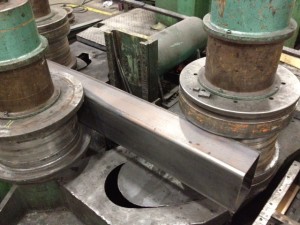When designing for the use of rolled steel shapes in any application, architects and engineers must take into consideration the fact that most bending and curving processes require a certain length of material on each end of the curve. This length of un-used, wasted material is required as pickup, in order for the machine to properly grip the member during the rolling/bending process.
The length required on each end of the bend is determined by what machine is used to curve the steel member. Smaller steel shapes from 1-4″–whether it be angle, beam, bar, or channel–usually only require 6-12″ of pickup on each end. As the size of the steel member increases; the amount of pickup required also increases. Steel shapes in sizes from 5-8″ will require any where from 18-24″, and larger steel members require 36-48″ of straight on each end. And the largest steel shapes that are able to be curved can require up to 96″ of un-curved, straight grip length on each end.

Architects and engineers who are designing with curved steel should work closely with bender/rollers in order to minimize the amount of scrap/pickup that is required. In some instances benders/rollers are able to nest multiple members within one piece, by rolling out longer lengths or each member and cutting them into sections after the desired radius is achieved. Since the machine only requires gripper length on each end of a single member, the steel shape can be as long as available, the only limiting factor to consider would be the area the member is curved in.
Lastly, some bending/rolling equipment requires virtually no pickup. Again, working with a company that specializes in curving steel can increase the chances of minimizing waste in manufacturing.







